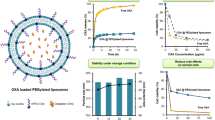Summary
The 14-O-palmitoyl ester of 3′-deamino-3′-hydroxydoxorubicin was synthesized to study the liposomal formulation and biological activity properties conferred by the attachment of a lipophilic group to position 14 of the anthracycline molecule. The entrapment efficiency of 14-O-palmitoyl-hydroxyrubicin in multilamellar vesicles composed of dimyristoylphosphatidyl choline and dimyristoylphosphatidyl glycerol was >99%. In addition, the stability of liposomes containing 14-O-palmitoyl-hydroxyrubicin was >99% at 14 days as assessed by the amount of drug leaking out of the liposomes and the absence of crystals of free drug in the liposome pellet. Esterilication at position 14 did not significantly decrease the potency of the parent compound 3′-hydroxydoxorubicin. Liposome-entrapped 14-O-palmitoyl-hydroxyrubicin was significantly more active than doxorubicin against two murine tumor models. Against ip L-1210 leukemia, liposome-entrapped 14-O-palmitoyl-hydroxyrubicin injected i.p. into mice at doses of 60 and 80 mg/kg resulted in a %T/C value (median survival of treated/control animals ×100) of >600, with 3–4 of 6 animals being cured, where-as in the same experiments, doxorubicin injected at the optimal dose (10 mg/kg) resulted in a %T/C value of 340, with 1 of 6 animals being cured. In animals bearing liver metastases of M-5076 reticulosarcoma, liposome-entrapped 14-O-palmitoyl-hydroxyrubicin showed significant antitumor activity when given on a three-i.v.-injection scheule of 20 mg/kg on days 4, 8, and 12 (%T/C, 175), whereas doxorubicin injected at optimal doses of 6–8 mg/kg on the same days was devoid of antitumor activity (%T/C, 129–133). These results indicate that esterification at position 14 enhances the affinity of this type of compounds for lipid bilayers without negatively affecting their biological activity.
Similar content being viewed by others
References
Balazsovitz JAE, Mayer LD, Bally MB, et al (1989) Analysis of the effect of liposome encapsulation on the vesicant properties, acute and cardiac toxicities, and antitumor efficacy of doxorubicin. Cancer Chemother Pharmacol 23: 81–86
Brown T, Kuhn J, Marshall M, et al (1991) A phase i clinical and pharmacokinetic trial of liposomal doxorubicin (NSC 620 212). Proc Am Soc Clin Oncol 10: 93
Conley BA, Egorin MJ, Zuhowski EG, et al (1991) Phase I and comparative pharmacokinetic study of liposome-encapsulated doxorubicin. Proc Am Soc Clin Oncol 10: 92
Gabizon A, Goren D, Fuks Z, et al (1985) Superior therapeutic activity of liposome-associated Adriamycin in murine metastatic tumor model. Br J Cancer 51: 681
Gabizon A, Meshorer A, Barenholz Y (1986) Comparative long-term study of the toxicities of free and liposome-associated doxorubicin in mice after intravenous administration. J Natl Cancer Inst 77: 459–469
Gabizon A, Peretz T, Sulkes A et al (1989) Systemic administration of doxorubicin-containing liposomes: a phase I study. Eur J Cancer Clin Oncol 25: 1795
Hart IR, Talmadge JE, Fidler IJ (1981) Metastatic behaviour of a murine reticulum cell sarcoma exhibiting organ specific growth. Cancer Res 41: 1271–1280
Herman EH, Rahman A, Ferrans V, et al (1983) Prevention of chronic doxorubicin cardiotoxicity in beagles by liposomal encapsulation. Cancer Res 43: 5427–5432
Hong CI, Kirisitz AJ, Buchheit DJ, et al (1986) 1-β-D-arabinofuranosyl cytosine conjugates of thioether phospholipids as a new class of potential antitumor drugs. Cancer Drug Deliv 3: 101–113
Horton D, Priebe W, Varela O (1984) Synthesis and antitumor activity of 3′-deamino-3′-hydroxyrubicin. A facile procedure for the preparation of doxorubicin analogs. J Antibiol 37: 853–858
Mayer LD, Bally MB, Hope MJ, Cullis PR (1985) Uptake of antineoplastic agents into large unilamellar vesicles in response to a membrane potential. Biochim Biophys Acta 816: 294–302
Mayer LD, Tai LC, Ko DS, et al (1989) Influence of vesicle size, lipid composition, and drug-to-drug lipid ratio on the biological activity of liposomal-doxorubicin in mice. Cancer Res 49: 5922–5930
Mayhew E, Rustum Y, Vail WJ (1983) Inhibition of liver metastases of M-5076 tumor by liposome-entrapped Adriamycin. Cancer Drug Deliv 1: 43
Mayhew EG, Goldrosen MH, Vaage J, et al (1987) Effects of liposome-entrapped doxorubicin on liver metastases of mouse colon carcinomas 26 and 38. J Natl Cancer Inst 78: 707–713
Murray JL, Kleinerman ES, Cunningham JE, et al (1989) Phase I trial of liposomal muramyl tripeptide phosphatidyl ethanolamine in cancer patients. J Clin Oncol 1915–1925
Perez-Soler R (1989) Liposomes as carriers of antitumor agents: towards a clinical reality. Cancer Treat Rev 16: 67–82
Perez-Soler R, Priebe W (1990) Anthracycline antibiotics with high liposome entrapment: structural features and biological activity. Cancer Res 50: 4260–4266
Perez-Soler R, Khokhar AR, Lopez-Berestein G (1987) Treatment and prophylaxis of exerimental liver metastases of M-5076 reticulosarcoma withcis-bis-neodecanoato-trans-R,R-1,2-diaminocyclohexaneplatinum(II) encapsulated in multilamellar vesicles. Cancer Res 47: 6462–6466
Perez-Soler R, Lopez-Berestein G, Khokhar AR (1989) Design and development of liposome-dependent antitumor agents. In: (eds) Liposomes in the therapy of infectious diseases and cancer. Alan R. Liss, New York, pp 59–69
Priebe W, Van T, Perez-Soler R (1991) Activity of 3′-deaminated anthracyclines against multidrug resistant cells. Proc Am Assoc Cancer Res 32: 378
Priebe W, Van NT, Perez-Soler R (1992) Biological consequences of deamination of doxorubicin. Cancer Res (in press)
Rahman A, Treat J, Roh JK, et al (1990) A phase I clinical trial and pharmacokinetic evaluation of liposome-encapsulated doxorubicin. J Clin Oncol 8: 1093–1100
Sears B (1983) Hydrophobic platinum compounds and their preparation. European Patent Application 0 113 508. European Patent Office
Treat J, Greenspan A, Forst D, et al (1990) Antitumor activity of liposome-encapsulated doxorubicin in advanced breast cancer: a phase II study. J Natl Cancer Inst 82: 1706–1710
Utsumi T, Hung MC, Klostergaard J (1991) Preparation and characterization of liposomal tumor necrosis factor. Cancer Res 51: 3262–3266
Vadiei K, Siddik ZH, Khokhar AR, Al-Baker S, Sampedro F, Perez-Soler R (1992) Pharmacokinetics and tissue distribution of liposome-entrappedcis-bis-neodecanoato-trans-R,R-1,2-diaminocyclohexaneplatinum(II) and cisplatin given i.v. and i.p. to the rat. Cancer Chemother Pharmacol (in press)
Author information
Authors and Affiliations
Additional information
Supported in part by NIH grant CA 50270
Rights and permissions
About this article
Cite this article
Perez-Soler, R., Priebe, W. Liposomal formulation and antitumor activity of 14-O-palmitoyl-hydroxyrubicin. Cancer Chemother. Pharmacol. 30, 267–271 (1992). https://doi.org/10.1007/BF00686293
Received:
Accepted:
Issue Date:
DOI: https://doi.org/10.1007/BF00686293




